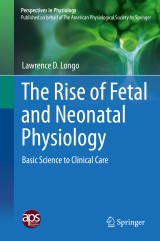Details

The Rise of Fetal and Neonatal Physiology
Basic Science to Clinical CarePerspectives in Physiology, Band 1
|
149,79 € |
|
| Verlag: | Springer |
| Format: | |
| Veröffentl.: | 15.09.2013 |
| ISBN/EAN: | 9781461479215 |
| Sprache: | englisch |
| Anzahl Seiten: | 533 |
Dieses eBook enthält ein Wasserzeichen.
Beschreibungen
<p>During the mid- to late-twentieth century, study of the physiology of the developing fetus and newborn infant evolved rapidly to become a major discipline in the biomedical sciences. Initially of interest from a standpoint of function of the placenta and oxygenation of the fetus, the field advanced to explore both normal functional mechanisms as well as pathophysiologic aspects of their regulation. Examples include studying the role and regulation of circulatory vascular anatomic shunts in oxygenation, cardiac function, certain aspects of asphyxia in the fetus and newborn infant, the role of fetal “breathing” movements, cyclic electroencephalographic activity, and analysis of electronic monitoring of fetal heart rate variability and its significance.</p><p>Included in this book are reminisces of several dozen individuals who played a vital role in these developments. Overall, this survey considers a number of aspects of the development of the science of fetal and neonatal physiology, and its role in the greatly improved care of pregnant women and their newborn infants. </p><p>This book is published on behalf of the American Physiological Society by Springer. Access to APS books published with Springer is free to APS members.</p>
<p>Introduction.- A Scientific Genealogy: The Development of Fetal-Neonatal Research.- Oxford and the Development of Physiology, with Notes on the Nuffield Institute.- Geoffrey S. Dawes: A Life in Science.- Dawes and Fetal Asphyxia: The Primate Colony in Puerto Rico.- Dawes, the Pulmonary Vasculature and his <i>Foetal and Neonatal Physiology</i>.- Embryology and Early Developmental Physiology.- Some Aspects of the Physiology of the Placenta.- Governmental Support of Research in Fetal and Newborn Physiology.- Fetal-Neonatal Growth and Metabolism.- Epigenetics and the Fetal Origins of Adult Heath and Disease.- Related Developments in Fetal and Neonatal Endocrinology.- Further Developments in Fetal and Neonatal Physiology.- Some Clinical Aspects of Developmental Physiology.- Bioethical Issues in Research on the Fetus and Newborn Infant.- Textbooks, Monographs and other Volumes on Fetal and Newborn Physiology.- Dawes and Fetal “Breathing” in the 1970s, and Fetal Heart Rate Analysis in the 1980s and early 1990s.- Dawes’ Contributions to Symposia and a Summing Up.- Dawes as a Mentor: Reminisces of Former Graduate Students, Postdoctoral Fellows, and Associates.- Early Years of the Society for Gynecologic Investigation, the Fetal and Neonatal.- Epilogue.- Index.</p>
<p>During the mid- to late-twentieth century, study of the physiology of the developing fetus and newborn infant evolved rapidly to become a major discipline in the biomedical sciences. Initially of interest from a standpoint of function of the placenta and oxygenation of the fetus, the field advanced to explore both normal functional mechanisms as well as pathophysiologic aspects of their regulation. Examples include studying the role and regulation of circulatory vascular anatomic shunts in oxygenation, cardiac function, certain aspects of asphyxia in the fetus and newborn infant, the role of fetal “breathing” movements, cyclic electroencephalographic activity, and analysis of electronic monitoring of fetal heart rate variability and its significance.</p><p></p><p>Included in this book are reminisces of several dozen individuals who played a vital role in these developments. Overall, this survey considers a number of aspects of the development of the science of fetal and neonatal physiology, and its role in the greatly improved care of pregnant women and their newborn infants.</p>
Constitutes a definitive history of an important field of physiology, that which concerns the developing fetus and newborn infant Addresses the contributions of basic scientists and physiologists to clinical problems of prematurity, such as the causes of premature labor, respiratory distress syndrome, retinopathy of prematurity, and thermoregulation Includes contributions from over 40 leading scientists in this field Includes supplementary material: sn.pub/extras
Diese Produkte könnten Sie auch interessieren:

The Neural Crest and Neural Crest Cells in Vertebrate Development and Evolution

von: Brian K. Hall

149,79 €















